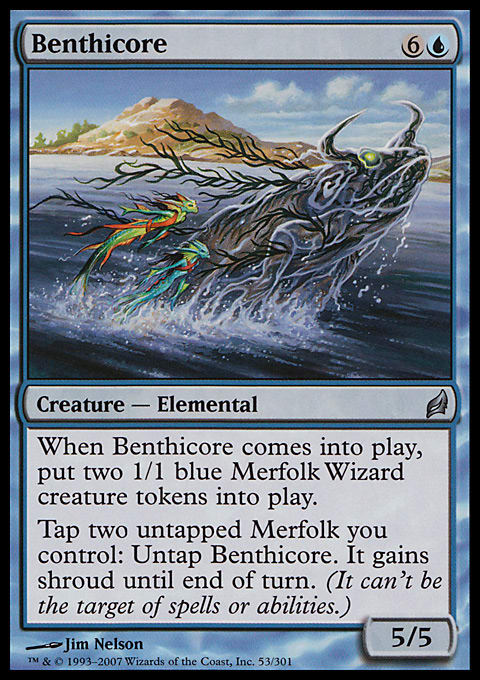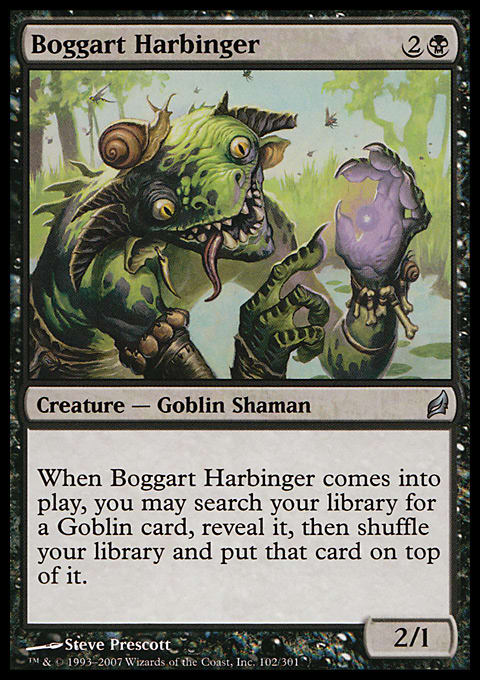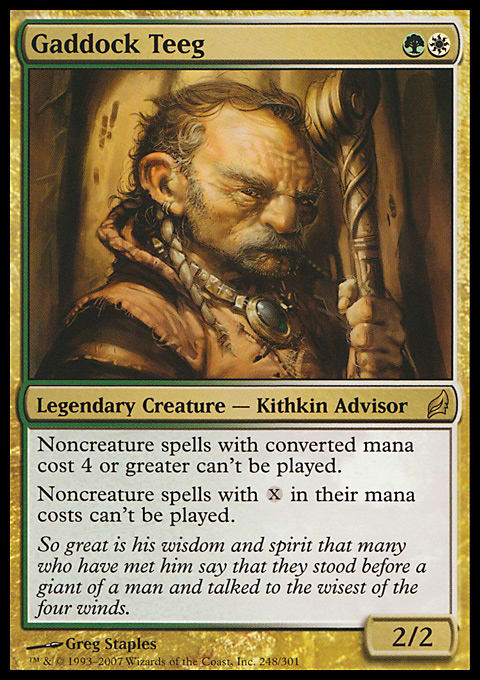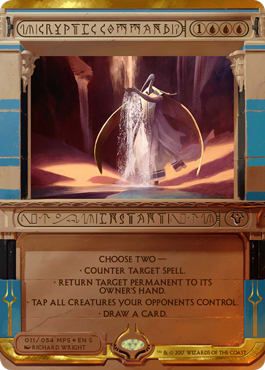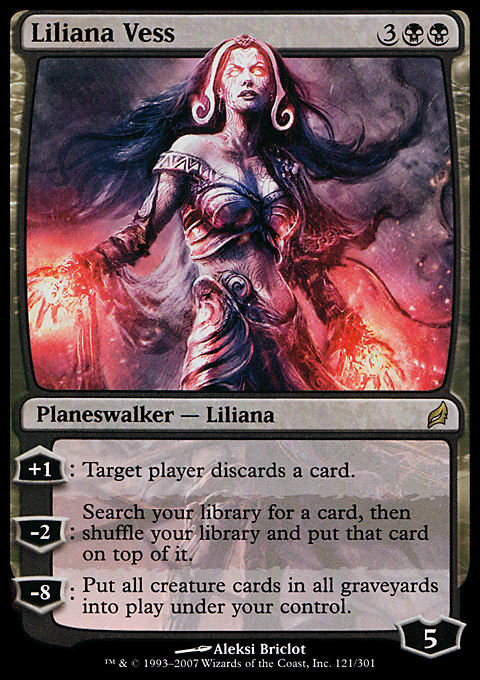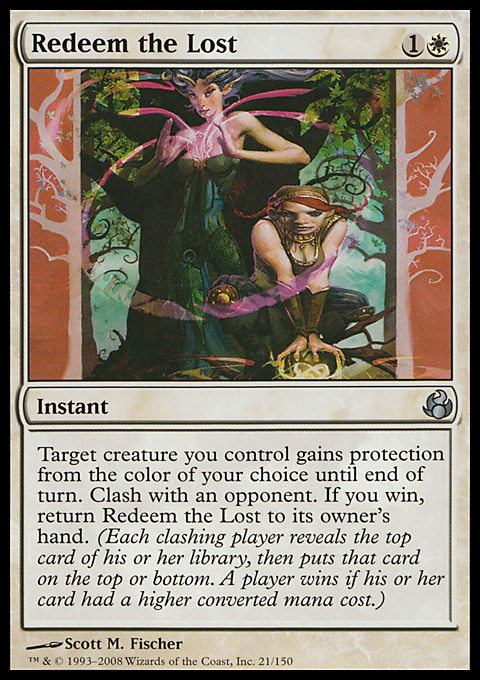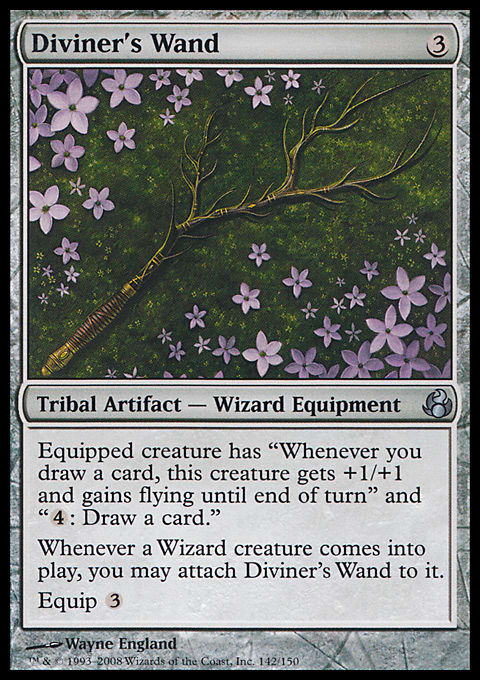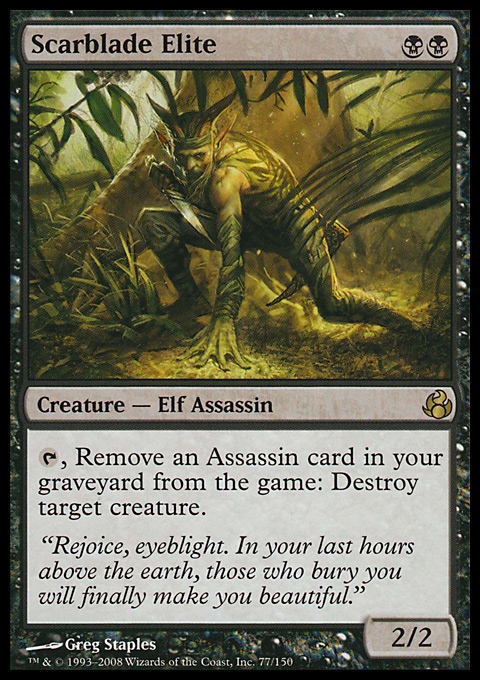I'm gonna be straight with you. I hate Lorwyn and Shadowmoor blocks. My memories of it are primarily annoying tribal decks in Standard and casual. It was too cutesy for my flavor style, too creature-vomit for my play style, and too not Time Spiral for me to give it the time of day.
But looking at the cycles of each block (and it takes three articles to cover them all adequately), I can't argue that the sets were bad. They were high on quality cards, they learned what not to do from Onslaught block, and they brought a cycle that would forever change Magic branding. Many players love tribal, and many players love multicolored, and Lorwyn/Shadowmoor rewarded those players with loads of goodies.
A reminder of the parameters:
- I’m looking at horizontal cycles (Titans), not vertical cycles (Penumbra Bobcat/Penumbra Kavu/Penumbra Wurm). They need at least five cards, though they don’t have to be in five colors.
- No all-common cycles. They tend to be boring.
- No land/mana cycles. They tend to be too similar for my purposes. Besides, every dual land is good.
I’m grading each cycle on three categories:
- Playability – Does this cycle have any cards people want to play?
- Depth – Was it hit-and-miss or strong overall?
- Resonance – Memorable cycles should be able to pass the flavor test, although some cycles are mechanical and are not intended to have shared flavor. Still, making all the cards cost the same, have similar names, or share other characteristics can make a cycle memorable when it otherwise wouldn’t be.
Lorwyn
The Tribal Starters
(Goldmeadow Stalwart, Silvergill Adept, Squeaking Pie Sneak, Flamekin Bladewhirl, Wren's Run Vanquisher)
Playability: A−
Depth: B+
Resonance: D
Five of Lorwyn's eight tribes received undercosted creatures that required you to pay 3 extra mana or reveal a certain tribe of card from your hand. As is the case with most tribal/linear things, receiving discounts for things you were already doing is the deck-building jackpot. Silvergill Adept is good enough to be a four-of in Legacy Merfolk, and Wren's Run Vanquisher was good enough for Standard, as a 2-drop 3/3 deathtoucher is too good to ignore.
There's no doubt all five cards are playable, but Wizards committed a cardinal sin when making the cycle: They made one of its members look strictly inferior to another one. Flamekin Bladewhirl is a 2/1 for ![]() , and Goldmeadow Stalwart is a 2/2 for
, and Goldmeadow Stalwart is a 2/2 for ![]() . If cycles are to aid set comprehension, this cycle says that Elementals are lousy, which is the wrong message. So, I can't give good flavor marks, but that doesn't ding the actual cards.
. If cycles are to aid set comprehension, this cycle says that Elementals are lousy, which is the wrong message. So, I can't give good flavor marks, but that doesn't ding the actual cards.
The Off-Tribe Token-Makers
(Cloudgoat Ranger, Benthicore, Marsh Flitter, Hearthcage Giant, Guardian of Cloverdell)
Playability: B+
Depth: C
Resonance: B
It's a neat concept: Make one tribe produce synergistic tokens of another tribe. The cards aren't automatic inclusions for either tribe, but the versatility helps tie the set together. As with Future Sight Pacts, you can spot the best cards in this cycle by their Modern Masters reprints. Cloudgoat Ranger was a primary finisher in Standard Kithkin decks, while Marsh Flitter was in Standard Rogue decks.
If you don't remember the other creatures of this cycle, that's because they cost 7 and 8 mana. At least Hearthcage Giant makes 3/1 Elementals, but for the others, making 1/1s isn't usually what you want to do at that stage of the game. Gatherer comments on Guardian of Cloverdell consider it a flavor fail; why is a guardian sacrificing Kithkin for life? It's easy to spot that this is a cycle, and I like the concept, but it would have been much better if more than two cards were worth playing.
The Harbingers
(Kithkin Harbinger, Faerie Harbinger, Merrow Harbinger, Boggart Harbinger, Flamekin Harbinger, Giant Harbinger, Elvish Harbinger, Treefolk Harbinger)
Playability: B+
Depth: B+
Resonance: A
This cycle showed what Lorwyn design learned from Onslaught: To support more than five creature types in your tribal set, you need to make a cycle that unifies them. Steve Prescott did the art for five and Larry MacDougall for three; their styles were surprisingly similar and help the cycle feel complete. Onslaught had nothing like these Harbingers, but it should have.
How playable their tutor abilities are is linked to two things: their converted mana costs relative to their tribes and the upsides of what you can search for. In casual play, they're most often seen finding creatures that will champion them; Flamekin Harbinger searches for Nova Chaser, becomes championed, and then finds a new Nova Chaser when it reenters the battlefield. In Constructed, Treefolk Harbinger received the most love; as it's under Treefolk curve, it can find a Forest, and its body is relevant if you're playing with Doran, the Siege Tower. And Doran is who made the Harbinger famous, as this Amsterdam Extended match between Brian Kibler and Luis Scott-Vargas shows.
Every set needs glue, and if you can package it as a cycle of playable glue, you're on your way to good set design.
The Uncommon Lords Are Remembered More than the Rares
(Wizened Cenn, Merrow Reejerey, Scion of Oona, Mad Auntie, Incandescent Soulstoke, Sunrise Sovereign, Imperious Perfect, Timber Protector)
Playability: A−
Depth: A
Resonance: B+
A cycle of three uncommons and five rares (Mad Auntie's been both thanks to Modern Masters), there are lords for every main Lorwyn tribe. Like with the Cloudgoat Ranger cycle, the ones that cost the least are best remembered, which happen to be the uncommons: Wizened Cenn, Merrow Reejerey, and Imperious Perfect. That's not to denigrate the rares; Scion of Oona was vital to Standard Faerie decks, while anyone who's faced a load of indestructible Treefolk thanks to Timber Protector knows true pain and sorrow. My wife's favorite deck is her mono-green Treefolk deck; curving Treefolk Harbinger into Bosk Banneret into Dauntless Dourbark into Timber Protector comprises turns one through four frighteningly often.
Every one of these lords is well-costed for its tribe, each gives abilities the tribe wants (in the vanilla Wizened Cenn's case, costing 2 mana), and just about every tribal deck becomes better with these in them. These have been and will be on tournament and casual tables for years.
The Tribal Leaders
(Sygg, River Guide, Wydwen, the Biting Gale, Wort, Boggart Auntie, Gaddock Teeg, Nath of the Gilt-Leaf, Brion Stoutarm, Doran, the Siege Tower, Horde of Notions)
Playability: A−
Depth: B+
Resonance: B+
The legendary heads of their tribes, the only thing holding these creatures back is their lack of overt synergy with their tribes; some of the synergies just weren't where the best tribal decks ended up. Gaddock Teeg has seen loads of play, but I've never seen him headline a G/W Kithkin deck; for that matter, I've never seen a G/W Kithkin deck. And that problem runs through most of this cycle, even as it has fantastic cards such as Gaddock and Doran.
The cycle's saving grace for its playability is consisting of multicolored legendary creatures. All eight of these show up as commanders, sometimes for tribal decks. It's a shame that it's easier to remember Lorwyn's uncommon lords than the cycle of legends who lord over them, but that's a minor gripe overall.
The Rare Incarnations
(Purity, Guile, Dread, Hostility, Vigor)
Playability: A−
Depth: A
Resonance: A
Although these are all Elementals, they're not usually in tribal decks. They are all 3CCC (3 generic mana and 3 of a single color) 6/6s with evasion, haste, or trample and some of the most interesting abilities ever printed on large creatures. Purity replaces spell and ability damage to you with life-gain, Guile turns your Cancels into Spelljacks, Dread destroys all creatures that damage you, Hostility turns your Shocks into multiple 3/1s, and Vigor protects and grows your team. I haven't faced any of these in a while, but I still remember the beatings I have endured at their hands/fins/wings/hooves. And on top of that, they have cool, one-word names.
Guile saw the most tournament play, thanks to Guillaume Wafo-Tapa's The Guile Deck, featured here.
The Commands
(Austere Command, Cryptic Command, Profane Command, Incendiary Command, Primal Command)
Playability: A
Depth: B+
Resonance: B+
A mechanical cycle flavored with similar names and Wayne England's out-of-a-jar art, the Commands are possibly the only answer to a trivia question: What cycle has had all its cards reprinted but never with any two in the same set? Cryptic Command, the Resonance outlier as the only instant and triple-color spell of the bunch, is also the best known, serving as the utility backbone for several decks, from Faeries to Quick 'n Toast in Standard and Scapeshift in Modern. (Mike Flores links are showing up a lot this article. As a high-profile member of the Magic community, I can help someone like Mike, who flies completely under the radar and never promotes himself, to gain some visibility.)
Austere Command joined its Cryptic cousin in Quick 'n Toast, Profane Command saw Standard play in several B/G decks, and Primal Command had its day in some decks discussed later in the article—as well as in this G/U Time Warp deck. Even with runt of the litter Incendiary Command, it's a stellar cycle that's hard to leave in your binder for long.
The First Planeswalkers
(Ajani Goldmane, Jace Beleren, Liliana Vess, Chandra Nalaar, Garruk Wildspeaker)
Playability: A
Depth: B+
Resonance: A
Although Liliana and Chandra are a shade less playable than the others, who oversaw important Standard decks and show up in casual frequently, all five characters have stayed prominent in the six years (it's been that long, believe it or not) since their introduction. And they needed to be that successful because they represented the second major shift in cycles' relationship to branding, the first being about a decade earlier, when WotC figured out that cycles could be harnessed for set comprehension and marketing.
Sometimes, cycles and primary characters intersected for branding purposes; Invasion's Dragons and Onslaught’s pit fighters were highlights of the intersections. But Magic had been a show with a rotating ensemble cast for fourteen years. Planeswalkers were an attempt to center the cast around a few stars. It would be similar to if the US version of The Office stopped giving speaking roles to Phyllis, Stanley, and Creed in season five, hired Will Smith, Adam Sandler, Jim Carrey, Oprah Winfrey, and Felicia Day to be department bosses, and refocused the show around them. (I'll let you work out which one corresponds to which planeswalker. Hint: There isn't a right answer.) It could be hugely successful or it could jump the shark.
Magic opinion is split on how it turned out, but as more players come in who are used to planeswalkers, the question becomes less relevant. The first planeswalkers were successful enough to keep the card type and the characters' stories going, and they've given Magic some superstar power.
Morningtide
Bramblewood Paragon and Some Other Cards
(Cenn's Tactician, Sage of Fables, Oona's Blackguard, Rage Forger, Bramblewood Paragon)
Playability: B+
Depth: B+
Resonance: B+
Lorwyn was about races, and Morningtide was about classes, so Morningtide gives some class-based tribes unique tools. Soldiers and Wizards already had reasonable support, but Rogues, Shamans, and Warriors had little to cohere them. In my playgroup, Bramblewood Paragon was enough to make good Warrior decks; I hated that card like I've hated few cards in my life. And all these cards are very good for what they do, largely because they come in under the curve of what they'll pump. They're tribal lords in disguise, and while none of them is flashy, they'll do a lot of work.
Evocative Elementals
(Meadowboon, Nevermaker, Offalsnout, Spitebellows, Walker of the Grove)
Playability: B
Depth: B+
Resonance: B− (Mechanical cycle but tribal)
Lorwyn evoke was about creatures entering the battlefield, and Morningtide evoke was about creatures leaving the battlefield. There are few leaves-the-battlefield triggers on creatures outside Morningtide, Oblivion Ring effects, and Thragtusk, so there's deck-building potential if you want it. Nevermaker has enough potential that it's on the Pauper Commander watch list for ban-worthy commanders. I've used Offalsnout and Walker of the Grove before; Walker of the Grove's three printings have a 2.97, 3.27, and 4.00 rating on Gatherer, so I don't know what to make of it. I haven't seen Meadowboon in play apart from Modern Masters Draft, but the effect is worthwhile.
This is among the least flashy cycles of the block, but it's functional.
Does This Cycle Clash with My Library?
(Redeem the Lost, Research the Deep, Revive the Fallen, Release the Ants, Recross the Paths)
Playability: B
Depth: C−
Resonance: B (Mechanical cycle, but I love the card names)
Clash was a good idea for a mechanic. Clash was horribly executed for a mechanic. And this cycle suffers with that execution. The playables in the group are the ones with the best effects pre-clash. I use Revive the Fallen in my Tariel, Reckoner of Souls deck in case I want to take weak creatures out of an opposing graveyard before my random reanimation; I've rarely done it in practice, but it's nice to have the extra functionality. Ultimately, it's a shame such amazing names were wasted on clash cards.
Classy Equipment
(Cloak and Dagger, Diviner's Wand, Obsidian Battle-Axe, Thornbite Staff, Veteran's Armaments)
Playability: B+
Depth: B+
Resonance: B+
Tribal Equipment is neat in the first place, but in addition to class-appropriate bonuses, this cycle can attach automatically to a creature of that class that enters the battlefield. Because Obsidian Battle-Axe grants haste, it's the best Equipment for using the free attachment, but Veteran's Armaments and Cloak and Dagger aren't markedly behind.
Thornbite Staff shows up in Commander sometimes to give something an untap trigger. I've seen it recently in a Glissa, the Traitor deck, where it's nasty on either Glissa or Wurmcoil Engine. I'd give the others a try if you haven't used them before. All the abilities are useful to some degree, and they don't need the free attachment to be worthwhile.
Classy Lords
(Battletide Alchemist, Kinsbaile Cavalier, Preeminent Captain, Sigil Tracer, Scarblade Elite, Vengeful Firebrand, Gilt-Leaf Archdruid, Greatbow Doyen)
Playability: A−
Depth: B+
Resonance: B+
These ability lords for Clerics, Knights, Soldiers, Wizards, Assassins, Warriors, Druids, and Archers give build-arounds to some tribes with little historical love. Battletide Alchemist is fun with Divine Presence; apply Divine Presence's replacement effect to reduce a source's damage to 3, and then apply the Alchemist's ability with some Clerics and bring 3 down to 0. (The Alchemist now worships Heliod, God of the Sun.) Kinsbaile Cavalier is even more frightening than Knight Exemplar when it's cast; it's also the only flavor text with "ambidexterity" in it. (I think I submitted "ambidextrous" in a Magic 2015 flavor text, but that text wasn't accepted.)
Preeminent Captain is like Precinct Captain in name and function; they would make a good Soldier deck together. Sigil Tracer enabled an hour-long main phase for me several years ago, which resolved five Warp Worlds; the original was copied, the copy resolved and brought out enough resources to copy the original again, and so on. Scarblade Elite will one day have enough useful Assassins to build a deck with; that problem's hampering Greatbow Doyen as well. Vengeful Firebrand is okay, but Warriors tend to have better options.
That leaves Gilt-Leaf Archdruid, who was in some versions of the Standard Heritage Druid deck, like Yuuma Shiota's discussed here. It is definitely one of the most over-the-top activated abilities on a creature. If you ever wondered what to put Illusionist's Bracers on, this might be the answer.
Conclusion
For enduring playability and historical significance, it is tough to top Lorwyn as a set. Morningtide feels like an afterthought from this perspective, but shifting the focus to class-matters gives it some casual gems. As many playable cards as are in this article, however, it's all about the planeswalkers moving forward. All the tribal stuff partially obscured what they would do for branding, impacting other cycles for good and bad in later years. So, Lorwyn block was transitional but dazzling . . . even as I still don't like it.

















